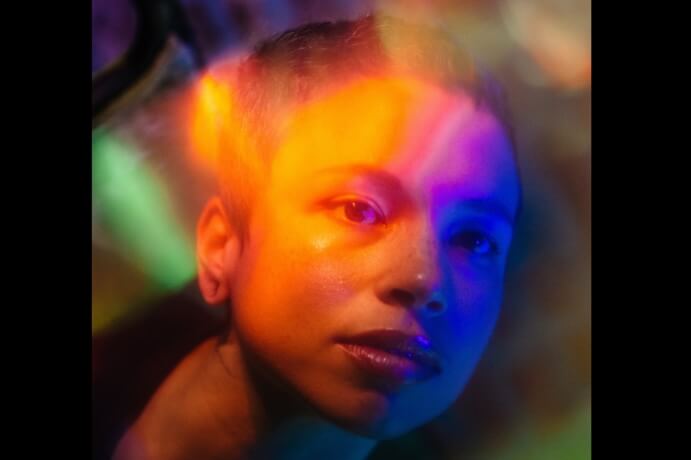An angelic hum pierced through the din of a crowd huddled on the third floor of the Whitney Museum of American Art. A twinkling electronic murmur underscored it like a puffy cloud. Heads turned, wondering where the sounds were coming from. And then, Holland Andrews appeared, gradually walking to a small raised stage at the front of the room to perform their latest piece, Speaker, for the Whitney Biennial. Their voice filled the gallery with grumbles, bird call-like flutters, and melismatic phrases. Much of their vocalizations transcended words, save for the phrase “don’t be afraid to be cracked open,” which emerged with striking clarity. It was an invitation to embrace Andrews’ experimentations, and to the vulnerability of their music.
Andrews is a New York-based vocalist, composer, producer, and performer whose music synthesizes vocals, clarinet, and electronics, sculpting meditative, immersive, and cathartic sound worlds from them. They’re one of seventy-one artists highlighted at the 81st edition of the Whitney Biennial, which runs through Aug. 11 and celebrates the swath of contemporary art happening today. As part of this year’s activities, Andrews composed Speaker and two sound installations: Air I Breathe: Radio and Hyperacusis Version 1: Sleeping Bag. The composition and the installations both blur lines between human and electronic, crafting organic, ruminative melodies. But mostly, they showcase their command of the voice and all its possibilities.
Holland Andrews — Photo by Geert Coppens
On Saturday, Jun. 29, just one of Andrews’ installations was up-and-running: Air I Breathe: Radio, which is located in the museum’s main staircase (Hyperacusis Version 1: Sleeping Bag, which is located in the freight elevator, was closed for the afternoon). The 60-minute piece distorts and manipulates their voice into a tangled web of sounds that shrink and grow in tandem. Practically, it functions more like environmental music than a piece to sit and absorb. As I paced up and down the stairwell, I noticed how their voice seemed to change at the rate of my steps, from quiet buzzes into bristling abstractions or glowing ambiance; it was barely there, a wisp of an idea floating through the hall. In the music’s quieter moments, no one walking through seemed to notice it — there was a photoshoot happening in the corner of floor three, a family of four chatting as they walked down to the lobby — but as Andrews’ voice crescendoed, people stopped and looked around, taking notice of their surroundings and allowing themselves to be immersed in the dreamy music.
Speaker built on the sound of the staircase, expanding it into a suite that explores Andrews’ thematic interests in catharsis and vulnerability by distorting short acoustic phrases through electronics. After the first part of the performance, Andrews ushered us into the theater, where we had the choice of sitting in chairs in the back of the room or large, black pillows situated at the front; I chose to lounge on a pillow, leaning into the meditative feeling of the space, which overlooked the Hudson River and was full of mystical smoke. Andrews stood at the front of the room behind a table that held a tangle of pedals and wires; they were backlit by a light machine spinning out neon colors that changed with every shift of their music, pulling us into each of the different sonic atmospheres they created.
Holland Andrews — Photo by Mengwen Cao
Throughout the piece, Andrews flew through a slew of different genre experiments that each focused on the different textures they could make using their voice, clarinet, and pedal station. Some moments leaned into airy, ambient sounds, some were dark and droning, while others still felt wistful. One particularly intriguing moment saw Andrews chop up their voice into a thousand samples, weaving them into a rhythmic patchwork as the lights around them swirled in a curdled blue, creating a sense of anxiety that gradually dissipated into a hazy melody. And while their voice still remained the core of the music, their use of clarinet was a highlight throughout the performance; it billowed and grumbled into their pedal station as if it were conjuring the absolute depths of human emotion.
Eventually, the smoke in the room began to lift, revealing Andrews at their most vulnerable once again. Though they sang for much of Speaker, only a few phrases were noticeable — “cracked open,” “I’m just scared,” “don’t be afraid,” and questions surrounding death — gesturing towards the turbulence of healing. As the piece neared its final chapter, the lights turned crisp white, and there was a final feeling of acceptance as Andrews let go of their fears. Their electronics ascended and their voice floated all the way up into the heavens, taking us with them for the ride.
I CARE IF YOU LISTEN is an editorially-independent program of the American Composers Forum, and is made possible thanks to generous donor and institutional support. Opinions expressed are solely those of the author and may not represent the views of ICIYL or ACF.
You can support the work of ICIYL with a tax-deductible gift to ACF. For more on ACF, visit the “At ACF” section or composersforum.org.

